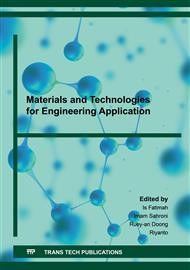[1]
W. S. Ritung, H. Subagjo, Peta sebaran lahan gambut, luas dan kandungan karbon di kalimantan/map of peatland distribution area and carbon content in kalimantan, 2000-2002. Wetlands International - Indonesia Programme & Wildlife Habitat Canada, Indonesia, 2004, p.234.
Google Scholar
[2]
Y. Uraki, Y. Tamai, M. Ogawa, S. Gaman, S. Tokura, Preparation of activated carbon from peat, Bioresource 4 (2014) 205-213.
Google Scholar
[3]
M. Karnib, A. Kabbani, H. Holail, Z. Olama, Heavy metals removal using activated carbon, silica, and silica activated carbon composite, Energy Procedia 50 (2014) 113-120.
DOI: 10.1016/j.egypro.2014.06.014
Google Scholar
[4]
P. Brown, S. Gill, S. Allen, Metal removal from wastewater using peat, Water Research 34 (2000) 3907–3916.
DOI: 10.1016/s0043-1354(00)00152-4
Google Scholar
[5]
G. Fadillah, E. N. K. Putri, S. Febrianastuti, E. V. Maylinda, C. Purnawan, Adsorption of Fe ions from aqueous solution using α-keratin-coated alginate biosorbent, Inter. J. Env. Sci. Dev. 9 (2017) 82-85.
DOI: 10.18178/ijesd.2018.9.3.1077
Google Scholar
[6]
F. Cao, C. Lian, J. Yu, H. Yang, S. Lin, Study on the adsorption performance and competitive mechanism for heavy metal contaminants removal using novel multi-pore activated carbons derived from recyclable long-root Eichhornia crassipes, Bioresource Technol. 276 (2019) 211-218.
DOI: 10.1016/j.biortech.2019.01.007
Google Scholar
[7]
A.M. Abioye, F.N Ani, Recent development in the production of activated carbon electrodes from agricultural waste biomass for supercapacitors: A review, Renew. Sustain. Ener. Rev. 52 (2015) 1282-1293.
DOI: 10.1016/j.rser.2015.07.129
Google Scholar
[8]
Z.S. Iro, C. Subramani, S.S. Dash, A brief review on electrode materials for supercapacitor, Int. J. Electrochem. Sci. 11 (2016) 10628–10643.
DOI: 10.20964/2016.12.50
Google Scholar
[9]
A. Ionnidou, Zabaniotu, Agricultural residues of precursors for activated carbon production-a review, Renew. Sustain. Ener. Rev. 11 (2007) 1705-1966.
Google Scholar
[10]
Y.Z. Zhang, Z.J. Xing, Z.K. Duan, M. Li, Y. Wang, Effect of steam activation on the pore structure and surface chemistry of activated carbon derived bamboo waste, App. Surf. sci. 315 (2014) 279-286.
DOI: 10.1016/j.apsusc.2014.07.126
Google Scholar
[11]
E. Taer, R. Taslim, W.S. Mustika, B. Kurniasih, Agustino, A. Afrianda, Apriwandi, Production of an activated carbon from a banana stem and its application as electrode materials for supercapacitors, Int. J. Electrochem. Sci. 13 (2018) 8428-8439.
DOI: 10.20964/2018.09.55
Google Scholar
[12]
S. Kumagai, M. Sato, D. Tashima, Electrical double-layer capacitance of micro- and mesoporous activated carbon prepared from rice husk and beet sugar, Electrochim. Acta 114 (2013) 617–626.
DOI: 10.1016/j.electacta.2013.10.060
Google Scholar
[13]
R. Farma, Deraman, Awitdrus, I.A. Talib, E. Taer, N.H. Basri, J.G. Manjunatha, M.M. Ishak, B.N.M. Dollah, S.A. Hashmi, Preparation of Highly Porous Binderless Astivated Carbon Electrodes from Fibers of Oil Palm Emty Fruit Bunches for Application in Supercapacitor, Bioresource technol. 132 (2013) 254-261.
DOI: 10.1016/j.biortech.2013.01.044
Google Scholar
[14]
J.F. González, S. Román, J.M. Encinar, G. Martínez, Pyrolysis of various biomass residues and char utilization for the production of activated carbons, J. Anal. Appl. Pyrolysis 85 (2009) 134-141.
DOI: 10.1016/j.jaap.2008.11.035
Google Scholar
[15]
E. Sari, Pasymi, U. Khatab, E.D. Rahman, Performance Evaluation of Rotary Carbonization Pyrolysis as Durian Shell Biobriquettes Raw Materials, Int. J. Eng. Tech. 4 (2018) 108-112.
Google Scholar
[16]
F. Li, W. Chi, Z. Shen, Y. Wu, Y. Liu, H. Liu, Activation of mesocarbon microbeads with different textures and their application for supercapacitor, Fuel Process Technol. 91 (2010) 17-24.
Google Scholar
[17]
D.B. Cullity Elements of X-Ray Diffraction, Ed. 3. Amazon: Prentice Hall (2001) p.253.
Google Scholar
[18]
P.J.M. Carrott, J.M.V. Nabais, M.M.L.R. Carrott, J.A. Pajares, Preparation of activated carbon fibres from acrylic textiles fibres, Carbon 39 (2001) 1543-1555.
DOI: 10.1016/s0008-6223(00)00271-2
Google Scholar
[19]
D. Qu, Studies of the activated carbons used in double-layer supercapacitors, J. Power Sources, 109 (2002) 403-441.
DOI: 10.1016/s0378-7753(02)00108-8
Google Scholar
[20]
A. Allwar, Characteristics of pore structure and surface chemistry of activated carbons by physisorption, FTIR and Boehm methods, IOSR J. App. Chem. 2 (2012) 9-15.
DOI: 10.9790/5736-0210915
Google Scholar
[21]
W.F. Smith, J. Hashemi, Foundations of materials science and engineering fifth edition in SI units. Singapore: The McGraw-Hill Companies, 2011, p.29.
Google Scholar
[22]
M. Smisek, S. Cerny, Active carbon, manufacture, propertis, and aplications. Amsterdam, Elsevier Publishing Company, 1997, p.109.
Google Scholar
[23]
W.S.K. Sing, H.D. Everett, W.A.R. Haul, L. Moscou, A.R. Pierotti, J. Rouquerol, T. Siemieniewska, Reporting physisorption data for gas/solid systems with special reference to the determination of surface area and porosity, Pure and Applied Chemistry 57 (1985) 603-619.
DOI: 10.1515/iupac.57.0013
Google Scholar
[24]
W.R. Li, D.H. Chen, Z. Li, Y.F. Shi, Y. Wan, G. Wang, Z.Y. Jiang, D.Y. Zhao, Nitrogen containing carbon spheres with very large uniform mesopores: superior electrode materials for EDLC inorganic electrolyte, Carbon, 45 (2007) 1757-1763.
DOI: 10.1016/j.carbon.2007.05.004
Google Scholar
[25]
R. Farma, R. Fadilah, Awitdrus, N.K. Sari, E. Taer, Saktioto, M. Deraman, Corn cob based activated carbon preparation using microwave assisted potassium hydroxide activation for sea water purification, J. Phys. Conf. Ser. 1120 (2018) 012017-012021.
DOI: 10.1088/1742-6596/1120/1/012017
Google Scholar
[26]
Z.M. Yunus, A. Al-Gheethi, N. Othman, R. Hamdan, N.N. Ruslana, Removal of heavy metals from mining effluents in tile and electroplating industries using honeydew peel activated carbon: A microstructure and techno-economic analysis, J. Cleaner Production 251 (2020) 119738-46.
DOI: 10.1016/j.jclepro.2019.119738
Google Scholar
[27]
M.A.A. Zaini, L.L. Zhi, T.S. Hui, Y. Amano, M. Machida, Effects of physical activation on pore textures and heavy metals removal of fiber-based activated carbons, Materials Today: Proceedings (2020) 1-6.
DOI: 10.1016/j.matpr.2020.03.815
Google Scholar


